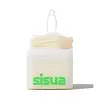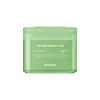What's inside
What's inside
 Key Ingredients
Key Ingredients

 Benefits
Benefits

 Concerns
Concerns

No concerns
 Ingredients Side-by-side
Ingredients Side-by-side

Water
Skin ConditioningDipropylene Glycol
HumectantGlycereth-26
HumectantBetaine
HumectantGlycerin
Humectant1,2-Hexanediol
Skin ConditioningHydroxyacetophenone
AntioxidantLactobacillus Ferment Lysate
Skin ConditioningCanavalia Gladiata Seed Extract
Skin ConditioningCeratonia Siliqua Seed Extract
Skin ConditioningGlycine Soja Seed Extract
Skin ConditioningLens Esculenta Seed Extract
Skin ProtectingPhaseolus Radiatus Seed Extract
Skin ConditioningPueraria Lobata Root Extract
HumectantAllantoin
Skin ConditioningPolyglyceryl-10 Laurate
Skin ConditioningEthylhexylglycerin
Skin ConditioningDisodium EDTA
Hydroxyethylcellulose
Emulsion StabilisingSodium Citrate
BufferingTasmannia Lanceolata Leaf Extract
Skin ConditioningCodium Fragile Extract
Skin ConditioningCitric Acid
BufferingMethyl Diisopropyl Propionamide
MaskingButylene Glycol
HumectantOlea Europaea Fruit Oil
MaskingSodium Benzoate
MaskingCitrus Medica Vulgaris Peel Oil
MaskingPotassium Sorbate
PreservativeRosmarinus Officinalis Leaf Oil
MaskingLitsea Cubeba Fruit Oil
MaskingFoeniculum Vulgare Oil
EmollientCoriandrum Sativum Fruit Oil
MaskingMentha Arvensis Leaf Oil
MaskingCentella Asiatica Extract
CleansingZea Mays Leaf Extract
Skin ConditioningWater, Dipropylene Glycol, Glycereth-26, Betaine, Glycerin, 1,2-Hexanediol, Hydroxyacetophenone, Lactobacillus Ferment Lysate, Canavalia Gladiata Seed Extract, Ceratonia Siliqua Seed Extract, Glycine Soja Seed Extract, Lens Esculenta Seed Extract, Phaseolus Radiatus Seed Extract, Pueraria Lobata Root Extract, Allantoin, Polyglyceryl-10 Laurate, Ethylhexylglycerin, Disodium EDTA, Hydroxyethylcellulose, Sodium Citrate, Tasmannia Lanceolata Leaf Extract, Codium Fragile Extract, Citric Acid, Methyl Diisopropyl Propionamide, Butylene Glycol, Olea Europaea Fruit Oil, Sodium Benzoate, Citrus Medica Vulgaris Peel Oil, Potassium Sorbate, Rosmarinus Officinalis Leaf Oil, Litsea Cubeba Fruit Oil, Foeniculum Vulgare Oil, Coriandrum Sativum Fruit Oil, Mentha Arvensis Leaf Oil, Centella Asiatica Extract, Zea Mays Leaf Extract
Water
Skin ConditioningButylene Glycol
HumectantMethylpropanediol
Solvent1,2-Hexanediol
Skin ConditioningHydroxyacetophenone
AntioxidantMelaleuca Alternifolia Leaf Water
AntimicrobialLactobacillus Ferment
Skin ConditioningDipotassium Glycyrrhizate
HumectantSodium Citrate
BufferingAllantoin
Skin ConditioningOctyldodeceth-16
EmulsifyingGlycerin
HumectantCitric Acid
BufferingDisodium EDTA
Melaleuca Alternifolia Leaf Oil
AntioxidantHydrogenated Lecithin
EmulsifyingMelaleuca Alternifolia Leaf Extract
PerfumingMangifera Indica Fruit Extract
Skin ConditioningWater, Butylene Glycol, Methylpropanediol, 1,2-Hexanediol, Hydroxyacetophenone, Melaleuca Alternifolia Leaf Water, Lactobacillus Ferment, Dipotassium Glycyrrhizate, Sodium Citrate, Allantoin, Octyldodeceth-16, Glycerin, Citric Acid, Disodium EDTA, Melaleuca Alternifolia Leaf Oil, Hydrogenated Lecithin, Melaleuca Alternifolia Leaf Extract, Mangifera Indica Fruit Extract
 Reviews
Reviews

Ingredients Explained
These ingredients are found in both products.
Ingredients higher up in an ingredient list are typically present in a larger amount.
1,2-Hexanediol is a synthetic liquid and another multi-functional powerhouse.
It is a:
- Humectant, drawing moisture into the skin
- Emollient, helping to soften skin
- Solvent, dispersing and stabilizing formulas
- Preservative booster, enhancing the antimicrobial activity of other preservatives
Allantoin is a soothing ingredient known for its protective and moisturizingg properties. Because of this, it is often added to products with strong active ingredients.
Studies show higher concentrations of this ingredient can promote wound healing.
Though it can be derived from the comfrey plant, allantoin is produced synthetically for cosmetic products to ensure purity.
Learn more about AllantoinButylene Glycol (or BG) is used within cosmetic products for a few different reasons:
Overall, Butylene Glycol is a safe and well-rounded ingredient that works well with other ingredients.
Though this ingredient works well with most skin types, some people with sensitive skin may experience a reaction such as allergic rashes, closed comedones, or itchiness.
Learn more about Butylene GlycolCitric Acid is an alpha hydroxy acid (AHA) naturally found in citrus fruits like oranges, lemons, and limes.
Like other AHAs, citric acid can exfoliate skin by breaking down the bonds that hold dead skin cells together. This helps reveal smoother and brighter skin underneath.
However, this exfoliating effect only happens at high concentrations (20%) which can be hard to find in cosmetic products.
Due to this, citric acid is usually included in small amounts as a pH adjuster. This helps keep products slightly more acidic and compatible with skin's natural pH.
In skincare formulas, citric acid can:
While it can provide some skin benefits, research shows lactic acid and glycolic acid are generally more effective and less irritating exfoliants.
Most citric acid used in skincare today is made by fermenting sugars (usually from molasses). This synthetic version is identical to the natural citrus form but easier to stabilize and use in formulations.
Read more about some other popular AHA's here:
Learn more about Citric AcidDisodium EDTA plays a role in making products more stable by aiding other preservatives.
It is a chelating agent, meaning it neutralizes metal ions that may be found in a product.
Disodium EDTA is a salt of edetic acid and is found to be safe in cosmetic ingredients.
Learn more about Disodium EDTAGlycerin is already naturally found in your skin. It helps moisturize and protect your skin.
A study from 2016 found glycerin to be more effective as a humectant than AHAs and hyaluronic acid.
As a humectant, it helps the skin stay hydrated by pulling moisture to your skin. The low molecular weight of glycerin allows it to pull moisture into the deeper layers of your skin.
Hydrated skin improves your skin barrier; Your skin barrier helps protect against irritants and bacteria.
Glycerin has also been found to have antimicrobial and antiviral properties. Due to these properties, glycerin is often used in wound and burn treatments.
In cosmetics, glycerin is usually derived from plants such as soybean or palm. However, it can also be sourced from animals, such as tallow or animal fat.
This ingredient is organic, colorless, odorless, and non-toxic.
Glycerin is the name for this ingredient in American English. British English uses Glycerol/Glycerine.
Learn more about GlycerinHydroxyacetophenone is antioxidant with skin conditioning and soothing properties. It also boosts the efficiency of preservatives.
This ingredient is not irritating or sensitizing.
Sodium Citrate is the sodium salts of citric acid. In skincare, it is used to alter pH levels and acts as a preservative.
Its main functions are to maintain the pH of a product and neutralize metal ions.
The acidity of our skin is maintained by our glands and skin biome; normal pH level of skin is slightly acidic (~4.75-5.5).
Being slightly acidic allows our skin to create an "acid mantle". This acid mantle is a thin barrier that protects our skin from bacteria and contaminants.
Learn more about Sodium CitrateWater. It's the most common cosmetic ingredient of all. You'll usually see it at the top of ingredient lists, meaning that it makes up the largest part of the product.
So why is it so popular? Water most often acts as a solvent - this means that it helps dissolve other ingredients into the formulation.
You'll also recognize water as that liquid we all need to stay alive. If you see this, drink a glass of water. Stay hydrated!
Learn more about Water